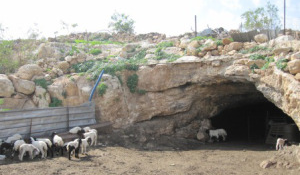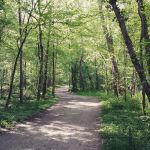
A new path
Sermon Preached at Westover Baptist Church, Arlington, Virginia April 23, 2017.
Two years ago, I was in transition: had been ordained, left a position I had completed and was looking for my next assignment. I began walking for fitness. This bulletin cover is my photo of one of the Fairfax County trails I frequented – it became a sanctuary of sorts, where I prayed, pondered and contemplated the Holy Spirit’s direction for my life. Although this trail looks empty, people did ride, walk or run by, mostly in a hurry; I heard birds, woodpeckers, frogs, fish gurgling in the creek; I saw foxes and deer often in the mornings. These natural elements in the midst of the city traffic helped me to feel God’s presence. This image is now my screensaver as a reminder to look to Jesus and for Him on my path. Feel free to use this image this week as you pray and meditate.
For today’s lesson, it might help us to remember a literary point. The Gospel writer Luke used several styles of writing – first, an “orderly account” investigated from eyewitnesses, a physician’s perspective, historian’s facts with a painter’s imagery, formal Greek language, and finally a creative tone of preacher/storyteller, like this passage. None of the styles were embellished or “fake news”; Luke’s accuracy was supported by contemporary historians like Josephus and Eusebius. But the creative side of Luke permits us to climb into the story and imagine ourselves there, on the road. The full passage reads as follows:
Luke 24:13-19: “Now that same day two of them were going to a village called Emmaus, about seven miles from Jerusalem. They were talking with each other about everything that had happened. As they talked and discussed these things with each other, Jesus himself came up and walked along with them; but they were kept from recognizing him. He asked them, “What are you discussing together as you walk along?” They stood still, their faces downcast. One of them, named Cleopas, asked him, ‘Are you the only one visiting Jerusalem who does not know the things that have happened there in these days?’ ‘What things?’ he asked. ‘About Jesus of Nazareth,’ they replied. ‘He was a prophet, powerful in word and deed before God and all the people’ so they continued to tell the stranger about the previous week.
Imagine hearing the whole Gospel read aloud like a movie – a good story has a beginning, a middle and an end, full of emotions as one experiences Jesus: his joyful birth, his compassionate healing ministry, instructive parables like the Good Samaritan, lost sheep, lost coin, the Prodigal Son and finally, the difficult Passion week we just experienced: from the shouted Hosannas of Palm Sunday, to Pilate’s and Herod’s mock trials of Jesus, the painful crucifixion of our Lord and Savior, and the expected yet surprising resurrection. Today, a week later, we find ourselves experiencing Jesus through several post-resurrection appearances (before his ascension to the Father – a period of 40 days). As we noticed in our Responsive Reading, those who saw him did not even know it was Jesus, until he revealed himself to them! None of these appearances were to the public – only for the disciples and close followers. It was not a matter of unbelief or doubt, but was about the unconditional acceptance of Christ’s incarnation and resurrection – they knew him in the flesh as a friend, a mentor, a teacher. They had been promised a resurrection, too, but in a world of persecution and destruction, no wonder they were worried and distracted about their own fate. Recall that Luke was written in the 80’s, after the temple had been destroyed and while Christians were in hiding.
Can you imagine the scene? The disciples were both sad and fearful: they had heard what the women at the tomb had seen, or not seen, so they were telling this stranger about Jesus’ missing body. And the stranger “said to them, how foolish you are, and how slow to believe all that the prophets have spoken! Did not the Messiah have to suffer these things and then enter his glory? Beginning with Moses and all the Prophets, he (the stranger) explained to them what was said in all the Scriptures concerning himself.”
After he refreshed their memory, this man was going farther down the road, but “they urged him strongly, “Stay with us, for it is nearly evening; the day is almost over.” By this time, because of the teaching, I imagine they felt a familiarity – you know a sort of déjà vu; they still did not know who he was, but they offered hospitality to this stranger! [Perhaps also because the roads were not safe at night] So this familiar stranger went in to stay with them. “When he was at the table with them, he took bread, gave thanks, broke it and began to give it to them. Then their eyes were opened and they recognized him, and he disappeared from their sight. They asked each other, “Were not our hearts burning within us while he talked with us on the road and opened the Scriptures to us?” Even though it is Cleopas’ house (we assume), the Guest, this familiar Stranger, acts as Host by breaking bread and pouring the wine. It is then through that remembrance and emotional connection, that they saw His nail-scarred hands, and recalled Jesus blessing Jesus the food for 5000 (and it is the same phrase we read at the Lord’s Supper), that their eyes are opened. They realize they had been with Jesus all along! Then Jesus vanished and appeared elsewhere to other disciples.
Their awareness and acceptance were significant. They began to recount the Emmaus journey and their years following Jesus, and their faith was strengthened. Their existing belief was affirmed; their worries resolved and hope was renewed!
3 points of the journey stand out to me. ONE, they welcomed the Stranger, even before he felt familiar; who knew the man they would meet that very day was God’s son?!!! || Perhaps like we would do at the office for a new employee over coffee, they told him what was going on in Jerusalem, but more likely they shared the news for his own protection. Still, he was accepted into their company and conversation. Do you automatically engage others in conversation when you meet them? TWO, the sharing of Scripture created a common bond between them. How true is that for us today? Do we know our Bible well enough to share verses with outsiders? More often, a planned Sermon, podcast or Bible Study discussion opens our eyes to God’s presence and/or to un-repented sin in our own lives. THREE, how generous they were to invite him to stay with them! “Whatever you did for one of the least of these brothers of mine, you did for me.” (Matthew 25:40) When all three experienced Table Fellowship together, their eyes were opened to the Messiah. “Where two or three come together in my name, there am I with them. (Matt 18:20)” and as commanded, “Love the Lord your God with all your heart and with all your soul and with all your mind and with all your strength. The second commandment is this: Love your neighbor as yourself.” (Mark 12:29-31)” Are you starting to perceive a directive?
I hope you listened to the lyrics of our hymns today; Doug had not read my sermon, only the passage, yet chose carefully the perfect pairing of music to message. Thank you, Doug! “The Master has called us . . . Immortal, invisible, God only wise . . . Open our eyes Lord, we want to see Jesus.” || I ask, would we recognize the risen, invisible Jesus on our life’s path? Would we welcome him, if he or she were a stranger? What if he or she was unbathed, poor and homeless? Would we welcome the stranger if he or she appeared to be mentally or physically ill? In our violent world, are we afraid of “the other?” True, we must use common sense, caution and our legal system as precautions, yet as Christ followers, are we not called to die to self, serve and include others; to meet the needs of those who cannot care for themselves. How do we live out that mandate?
Yes, we spiritually and financially support local and global organizations that feed the poor; house the homeless and heal and comfort the diseased. We go to Haiti, Senegal, etc.; we tell our conversion stories; we share the Gospel message of Jesus to those who have not yet heard. We pray; we fast; we study and learn Scripture to share. We invite the Stranger to events and fellowships like Friends and Family Sundays and Movie Nights! (and if we don’t then we should!) As Christ followers, we offer hospitality and care. I saw this with my client in a post-surgery rehab setting – caregivers, nurses and doctors who sacrificed much to serve. And though Westover receives some small benefit, we offer space in our church building to others as community outreach and as a Christian example. If we are to fulfill the Great Commission (the last paragraph of our Responsive Reading), we must begin to and consistently recognize Jesus through the Holy Spirit, so we can introduce others to Him.
Jan told us at Easter breakfast how she had experienced God’s direction through her clients’ words, mostly because she was listening! And so, I challenge you to become aware of the people along your own Emmaus road, who may be “Jesus” to you or who may need to see the “Jesus” in you! They could be co-workers, family members, neighbors, building partners; business acquaintances, gym workout pals, your plumber, electrician, hair stylist, barber, fraternity brother, and yes, even strangers at the grocery store or car wash! Are you treating them with an open heart and mind to hear their story? Are you willing to build a relationship with a stranger? Or like the disciples on that road, are you distracted by fears, life’s busy-ness or personal burdens? Yet, Jesus did not give up on them! He won’t give up on you!
Are you open enough to hear our risen Lord Jesus speaking to you through the Holy Spirit? Is your heart burning within you to be Transformed? Will you recognize Jesus?


 The Sheepfold (image) was basically a cave or a pen where several shepherds could gather their flocks for the night, to protect the sheep and themselves from the cold, the weather and predators. The “GATE” to the cave or enclosure also gave the shepherd a chance to examine his sheep for injuries of the day (he used his lowered staff over the gate to slow down entry), and provided a time for physical rest/sleep. Even so, thieves and robbers tried to steal the sheep for their meat, milk or wool by climbing over the fence or sneaking into the cave through another entrance. The readers of the day probably understood that the sheepfold referred to the Temple (in their minds the Holy place of God’s protection) and the thieves to the Religious leaders, who “stole” money and God from the people. According to Margaret Barker’s 2014 book, King of the Jews, Temple Theology in John’s Gospel, “Corrupt priests would destroy the light of the law, plunder the offerings, deride the sacred things and live dissolute lives.” Contemporary texts both Jewish and Christian confirm that the images of the gate/door and the conflict between good and evil were about the high priests and access to the holy city, to the temple and to its teaching. Gate was also deliberately ambiguous by Jesus and this author, referring 1. to the Sheepfold’s gate, 2. this Temple entry Gate and 3. Jesus as the only Gate to God in both relationship here on earth and in Heaven.
The Sheepfold (image) was basically a cave or a pen where several shepherds could gather their flocks for the night, to protect the sheep and themselves from the cold, the weather and predators. The “GATE” to the cave or enclosure also gave the shepherd a chance to examine his sheep for injuries of the day (he used his lowered staff over the gate to slow down entry), and provided a time for physical rest/sleep. Even so, thieves and robbers tried to steal the sheep for their meat, milk or wool by climbing over the fence or sneaking into the cave through another entrance. The readers of the day probably understood that the sheepfold referred to the Temple (in their minds the Holy place of God’s protection) and the thieves to the Religious leaders, who “stole” money and God from the people. According to Margaret Barker’s 2014 book, King of the Jews, Temple Theology in John’s Gospel, “Corrupt priests would destroy the light of the law, plunder the offerings, deride the sacred things and live dissolute lives.” Contemporary texts both Jewish and Christian confirm that the images of the gate/door and the conflict between good and evil were about the high priests and access to the holy city, to the temple and to its teaching. Gate was also deliberately ambiguous by Jesus and this author, referring 1. to the Sheepfold’s gate, 2. this Temple entry Gate and 3. Jesus as the only Gate to God in both relationship here on earth and in Heaven.





![10466730_10152435851730272_2097726240_n[1]](https://pmoyer20.files.wordpress.com/2015/06/10466730_10152435851730272_2097726240_n1.jpg?w=150&h=100)

